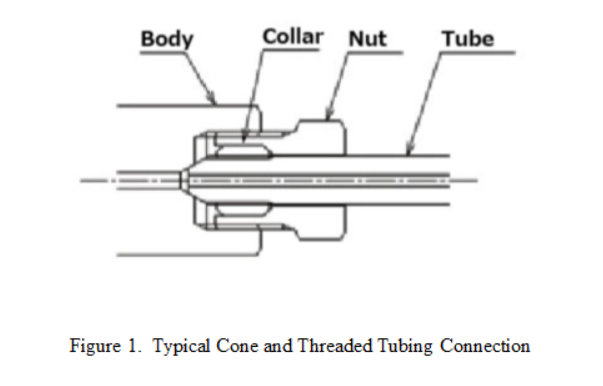While there are many ways to seal systems containing high pressure liquids and gasses, the most common method of sealing in high pressure plumbing is the use of conical metal to metal sealing. This method is particularly common in waterjet systems, both in the pump and in the plumbing carrying high pressure water from the pump outlet to the cutting head. This method also sees extensive use throughout chemical plants and in high pressure food processing systems. This sealing joint type, when applied to high pressure tubing, is known generically as a “cone and threaded” connection.
The operating principal of this connection is that the male cone on the tube end is pressed into the mating female cone with a mechanical preload, so the preload exceeds the subsequently applied pressure load tending to separate the parts. In doing so, the magnitude of the bearing pressure between the contacting surfaces of the mating metal cones remains higher than that of the applied fluid pressure when that pressure is applied, preventing passage of the pressurized fluid between the cone surfaces as a leak.
As observed in Figure 1, after sliding the male threaded gland nut over the tube, a collar is threaded onto the coned and threaded tube end. The gland is then threaded into a fitting body, pump outlet or pressure vessel head, engaging the collar and pushing the coned surfaces together. Torquing the gland nut at assembly provides the preload necessary to affect the pressure seal. The sealing cones are generally around 60o included angle, with the angle of the male cone being slightly smaller than that of the female. This difference in angles biases the conical sealing surface contact stresses to be higher near the fluid path bore, minimizing the required preload torque on the joint. A vent hole is necessarily included o provide a path for the fluid from a seal leak to escape without unsafe pressurization of the gland port. Material selection of the joint sealing components should is made considering potential corrosion and stress-corrosion effects, which can degrade performance over time.
The simplicity of this sealing system provides for high reliability, provided the sealing surfaces are free of flaws and not excessively deformed by overtightening. Inspection of these sealing surfaces during servicing is recommended. The tube ends are generally able to be coned and threaded using hand tools, although larger or higher strength tubes may be better prepared by machining. It is important to follow instructions for lubrication of the collar and gland threads, as well as applying the proper torque when specified. Lubrication of the conical sealing surfaces is also sometimes specified. Caution is advised for use of this type of sealing system in food pressure-processing equipment, as food-compatible greases may be required. It is also good practice to not put a wrench on this type of connection unless first carefully checking that the system is depressurized, in order to avoid potential unsafe exposure to a high pressure fluid release, or a whipping injury from joint separation in the case of a partially broken gland nut or tube experiencing metal fatigue cracking.


